The Headgear of Ancient Egypt
Since I was a child art historian (there is such a thing), I have been fascinated by the art and culture of ancient Egypt. Aside from the amazing continuity of almost 3000 years in their canonized art forms, I have always found the vast variety of headdress worn by members of the ruling class very interesting. In this offering, I’m showing some of the headgear worn by the pharaohs (both male and female).
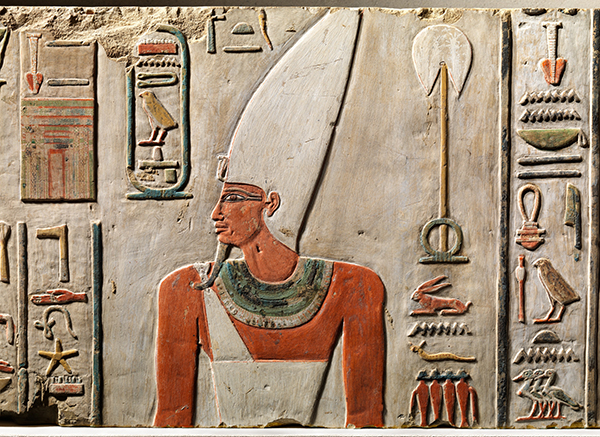 |
| Ancient Egypt, Middle Kingdom, Relief of Nebhepetre Mentuhotep II and the Goddess Hathor (detail), from his tomb at Deir-el-Bahri, 2010–2000 BCE. Painted limestone, height: 14 1/16" (36 cm). The Metropolitan Museum of Art, New York. (8S-30041) |
The meaning and protocol of crown wearing was firmly established from depictions of the earliest pharaohs of Egypt such as Narmer (ca. 3150–3100 BCE). This custom continued until the Greek and Roman periods (ca. 332 BCE–600s CE). One of the earliest reliefs depicting the White Crown, or hedjet, dates to Narmer’s period. Above is the Middle Kingdom pharaoh Mentuhotep II (ca. 2061–2010 BCE) in the hedjet. This crown was the symbol of upper Egypt, the region between Aswan and Atfih on the Nile, which is south of Cairo.
Mentuhotep was revered as the pharaoh who reunified Egypt after a period of civil wars. The pharaoh descended from a family of rulers in Thebes in Upper Egypt. He wears the false beard, symbolic of his connection to Osiris, the lord of the Dead, who was always depicted with a beard. The red ochre color of his skin was the tradition in Egyptian art for male figures for the culture's entire artistic history. He is depicted in the traditional combination of profile and frontal views.
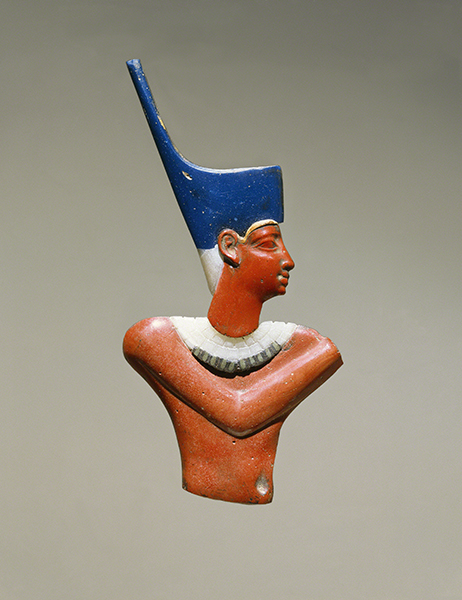 |
| Ancient Egypt, Late Kingdom, Figure of a King, 305–30 BCE. Molded glass in four parts, 5 ½" x 2 3/8" (14.1 x 6 cm). © 2020 Brooklyn Museum. (BMA-4943) |
Almost three thousand years after Narmer, crown traditions persisted in Egypt in the depiction of pharaohs. This unknown pharaoh wears the deshret crown, the symbol of Lower Egypt. Lower Egypt is the region around the Nile between Atfih south of Cairo up to the Nile River delta. The New Kingdom ended with the reign of Ramses XI (ruled 1099–1069 BCE). A period of instability and warfare followed, called the Third Intermediate Period (ca. 1069–715 BCE). Egypt had lost most of the territory gained under Ramses II (ruled 1279–1213 BCE). There were political rivalries among the wealthy priests of Thebes and contenders from other cities.
With pretenders to pharaoh numbering in four cities at one time, Egypt was ripe for invasion, first Libyan, then Nubians, then Kushites. Finally, the Assyrians horned in. All that time there were regional rulers, and it was one of these—Psamtik of Sais—who managed to force the Assyrians out of Egypt and reunite the country under Dynasty XXVI (664–525 BCE), thus initiating the Late Kingdom (ca. 664–332 BCE).
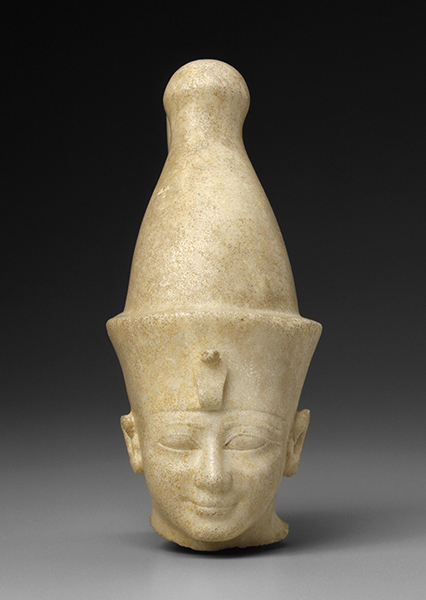 |
| Ancient Egypt, New Kingdom, Head from a Kneeling Figure of Amenhotep II, 1427-1400 BCE. Marble, 5 3/8" x 2 3/8" x 3 1/8" (13.6 x 6 x 8 cm). © 2020 Museum of Fine Arts, Boston. (MFAB-691) |
The pharaoh often wore a crown that combined the shapes of the hedjet and deshret into one enormous headgear for ceremonial and religious occasions. The Double Crown is known as the pschent. As a symbol, it emphasizes that the pharaoh rules both Upper and Lower Egypt. The uraeus (serpent) diadem on the forehead is also a symbol of the pharaoh’s divine kingship. The serpent was a symbol of the ancient goddess Wadjet, who was the protector of Lower Egypt, so it is positioned on the part of the pschent that is the crown of Lower Egypt. Amenhotep II (died 1400 BCE) was the seventh pharaoh of Dynasty XVIII, ruling Egypt at the height of its imperial power. His military campaigns in the Middle East secured loyalty oaths from the Mitanni, Babylonian, Hittite, and Assyrian cultures.
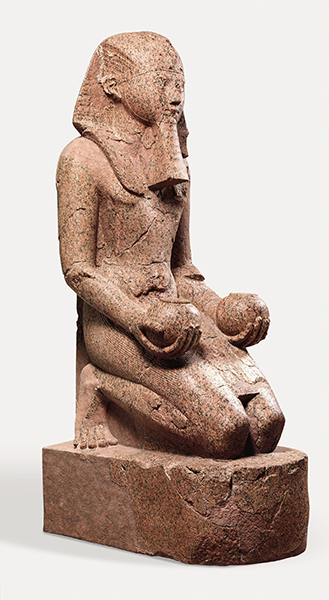 |
| Ancient Egypt, New Kingdom, Kneeling Figure of Hatshepsut, from her funerary complex at Deir-el-Bahri, 1479–1419. Granite, 103 1/2" x 31 ½" x 54" (261.5 x 80 x 137 cm). Metropolitan Museum of Art, New York. (APAH-021) |
The most common headgear seen in sculptures and wall paintings of pharaohs was the nemes headdress. Like most art from ancient Egypt, it dates back to the Old Kingdom (ca. 2650–2152 BCE). Striped or goffered linen was affixed to a band across the forehead. Each side of the linen was cut into rounded, starched tapers called “lappets,” which hung forward on the shoulders. In back it was pulled into a “ponytail” of fabric that was an imitation of the lion’s tale, another symbol of kingship.
The nemes was reserved only for royalty, and gods were often depicted wearing it. Hatshepsut was one of only four women to rule Egypt alone as pharaoh. She declared herself pharaoh and ruled from about 1478 to 1458 BCE, succeeding her father Thutmose I (ruled 1504 –1492 BCE). She was the wife of her half-brother Thutmose II (ruled 1492–1479 BE), and stepmother of Thutmose III (ruled 1473–1426 BCE), whose reign was delayed by Hatshepsut's after she had herself declared pharaoh by the priests of Ra. By having herself depicted in the traditional trappings of the (male) pharaoh, she legitimized her reign. Wearing the Osirian false beard also bore witness to her divine kingship.
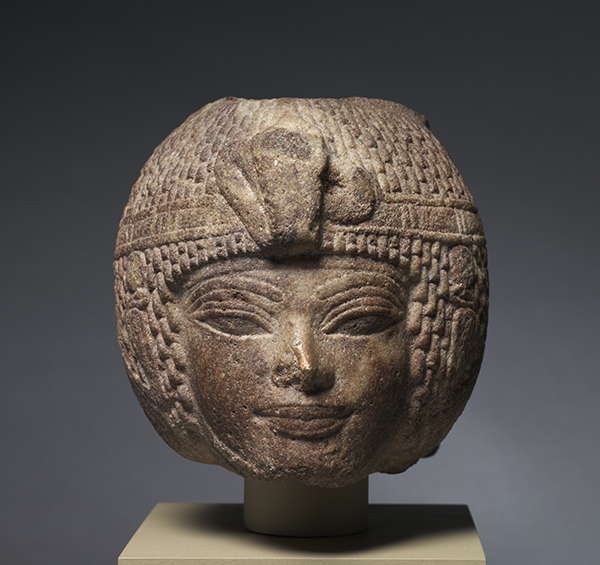 |
| Ancient Egypt, New Kingdom, Amenhotep III in the Round Wig, 1391–1353 BCE. Quartzite, 6 13/16" x 6 11/16" x 10" (17.3 x 17 x 25.3 cm). The Cleveland Museum of Art, Leonard C. Hanna Jr Fund, 1961.417. (CM-317) |
The “round wig” was fashionable during the New Kingdom for pharaohs and upper-crust people alike. Wigs were worn in ancient Egypt since the Old Kingdom. They were routinely made from human hair stiffened with beeswax, available only to the nobility. People of more humble origins wore wigs made of linen fibers and animal fur. Over his wig, the pharaoh Amenhotep III (ca. 1386–1353 BCE) wears the seshed diadem, consisting of a gold circlet containing the uraeus serpent. The symbol of the pharaoh’s divine kingship, the uraeus was often depicted on images of the gods. Amenhotep III was the father of Akhenaten (died 1335 BCE) and grandfather of Tutankhamun (died 1323 BCE). His greatest achievement was maintaining peace and prosperity in Egypt and contributing greatly to the arts. He is particularly renowned for his additions to the major temples in Karnak and Luxor.
Correlations to Davis programs: The Visual Experience 3E: 15.3; Discovering Art History 4E: 5.3


Comments